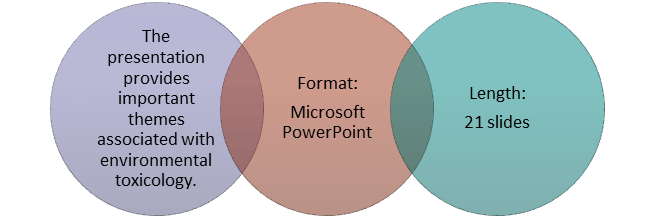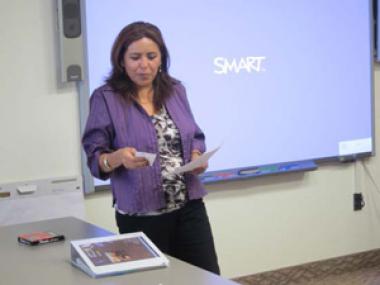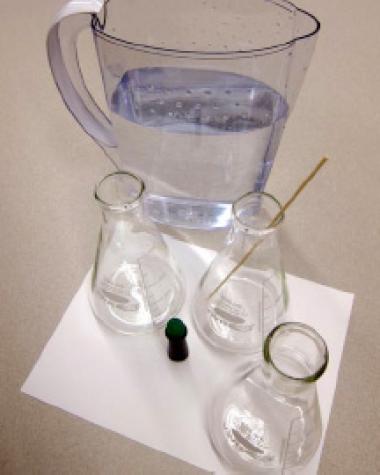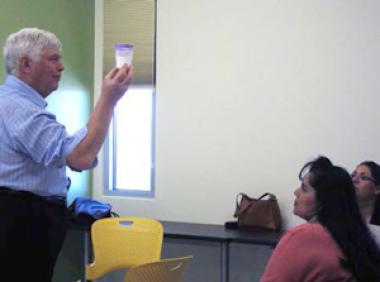Environmental Toxicology: Training Tools
Video Resources – More Information on Environmental Toxicology
This section provides video suggestions that may help in preparation for the training or can be utilized as a training tool to help trainees understand theme concepts. Some of the videos can also be used as visual demonstrations when you are not able to set-up real-life activities. Here are some suggested video resources that contain relative information, but please feel free to research others:
- Toxicology Education Foundation: Is It Safe? Dose Makes the Poison
- Flinn Scientific: Basic Principles of Toxicology
- A Borde de la Ciencia TV: Toxicología Ambiental (Spanish)
- Annenber Learner Classroom Resources.: The Habitable Planet: A Systems Approach to Environmental Science – Risk, Exposure, and Health
- WGBH, Greater Boston: Did Environmental Exposure Cause Disease Clusters?
Visual Aids – PowerPoint Presentation
The PowerPoint presentation provided is a prepackaged visual aid that can be utilized to train promotores on the respective theme of the module. It is meant to be adaptable and should be modified according to the audience needs and knowledge base. The information in the presentation is similar to that in the “background” section of this module. Certain terms and/or ideas may not be in the “background” section, thus a separate glossary is provided in this section to assist in defining. Click HERE to download the presentation.
Concept Glossary
- Strychnine – a highly toxic, colorless poison used as a pesticide to kill small mammals or birds. Usually, strychnine poisoning results in muscular convulsions and/or death. It has been around since the 1700s and is extracted from the plant Strychnos (genus) found in Asia, America, and Africa.
- Ethanol – pure alcohol.
- DDT – or dichlorodiphenyltrichloroethane, is an organchlorine pesticide used to kill various insects. It was developed in 1874 and in World War II it was used to control malaria and typhus.
- Curare – a paralyzing poison used by indigenous groups in South American. It is applied to arrows or blowgun darts that are employed to hunt prey. The paralyzing toxin leads to the inability to breath since lung muscles cannot contract.
- Dioxin – group of chemicals that are formed during the burning of waste and forest fires as well as some industrial processes such as paper pulp bleaching and herbicide manufacturing. They are considered very dangerous chemicals.
- Botox® – is used for various cosmetic and medical procedures. It derived from the bacteria Clostridium botulinum. The toxin produced by this bacterium is the most toxic substance known to humans.
- Morphine – is an opiate used to relieve sever pain.
- TCE – or trichloroethylene, is a chlorinated solvent used as an industrial degreaser. It is one of the most common environmental contaminants and commonly found in a majority of the Superfund site (most contaminated sites in the U.S. that are being cleaned-up under the supervision on the US EPA).
- PCE – or tetrachloroethylene, is a chlorinated solvent used mainly as a dry cleaning degreaser/cleaner.
Training Assessments and Extensions
- Have the promotores develop a list of toxicants they are familiar with and add beside each toxicant the respective health effects. After they create this list have them label the effects as either acute or chronic.
- Draw a dose-response curve for a familiar substance of their choice. Have them plot the responses in relation to the dose of the substance. Have them share the curve they created with the other promotores.
- Provide the promotores with copies of the canned mushrooms, pain relief ointment, deodorant, and aspirin labels. Have them choose which ingredient is the most toxic. An answer key has been developed demonstrating the lethal doses of the ingredients.
Concept Activities
These complimentary activities were designed to provide a hands-on component to the module trainings. They may be used to demonstrate a concept to visual learners or reinforce ideas presented to ensure comprehension. The activities have been divided into three sections (warm up, activity, and wrap up) in order to guide promotores through the concept(s). Also, some activities have “cheat sheets” for the trainer or handout materials that can be copied and handed out to the promotores at the training. Similar to other components in these modules, they may be adapted as needed considering training time, knowledge base, or available materials.
Activity 1. Every Day Chemical Bingo
Materials
- Copies of the Commercial Products Bingo Cards (one copy per each promotor)
- Large lima beans (place the cards on the table; commercial product illustrations facing up)
- Commercial Products Deck of Cards (print out on thick paper stock and create the deck of cards by cutting along dotted lines)
- Prize (optional; provide a small prize to the winner)
Warm Up
Ask the promotores to think about the products they have used prior to attending the training (you may want to provide a personal example so they can get the idea).
Activity
- Promptly hand out the Commercial Products Bingo Cards to the promotores.
- At the same time, give the promotores enough large lima beans to cover all the products on the cards (total of 16).
- Inform the promotores that they will be playing bingo. Mention to them that this bingo game is not the traditional one, but instead they will be placing a lima bean on each of the commercial products that you call out and they have used prior to their arrival to the training.
- Let them know that the person that fills out their card first or has the most products covered at the end of the game wins (optional: prize).
- Shuffle the Commercial Products Deck of Cards a few times.
- Select the top card from the Commercial Products Deck of Cards and say out loud the product name. Have them cover the product on their bingo card with the lima bean.
- Repeat Step 4 until some one covers all their bingo card products or you have finished the cards in the deck (the person that has the most products covered on their card wins).
Wrap Up
| item | substance |
|---|---|
| Stain Repellent Fabric | Perfluorinated chemicals and perfluorooctanoic acid |
| Cellular Phone | Electromagnetic radiation |
| Vehicle Exhaust | Carbon monoxide, nitrogen dioxide, sulfur dioxide, suspended particles, benzene, formaldehyde, and polycyclic hydrocarbons |
| Non-Stick Coated Cookware | Polymer fumes, perfluorinated chemicals |
| Plastic Containers/Bottles | Polyvinyl chloride, bisphenol a, and phthalates |
| Pressed Wood Products | Formaldehyde |
| Dryer Sheets | Benzyl acetate, benzyl alcohol, ethanol, alpha-terpineol, ethyl acetate, camphor, chloroform, linalool, and pentane |
| Flame Retardants on Furniture | Polybrominated diphenyl ethers. |
| Vinyl (PVC) Mini-Blinds | Lead, phthalates and vinyl chloride |
Tell the promotores that may times we do not consider the products that we use for personal hygiene as chemical substances. Have them discuss their familiarity with the chemicals that are found in these everyday products. Remind them that we live in a world filled with chemicals, and that it is very difficult to avoid exposure. Discuss other items they use or encounter regularly that contain chemicals (Table 2). Do they know what chemicals they contain?
Activity 2. Dose Demonstration*
Materials (Picture 1)
- Three Erlenmeyer flasks (at least 400 milliliters or mL; you can also use large glasses alternatively)
- 900 mL of water
- Food coloring
- One stir stick
- One sheet of white paper
Warm Up
Tell the promotores that a cliché within toxicology is, “the dose makes the poison.” Remind them that the information they are learning in the training can help them make informed decisions about environmental contaminants as well as health choices for their families, community, and themselves. Mention to them that you will be providing a demonstration that will help them understand the concept of dose.
Activity
- On a table, place the three Erlenmeyer flasks and fill them ¾ full of water (or 300 mL or about 1.25 cups).
- Add one drop of food coloring to the first Erlenmeyer flasks, five drops to the second beaker, and fifteen drops to the third beaker.
- Stir each Erlenmeyer flasks with the stir stick.
- Ask the promotores what differences they observe between the three Erlenmeyer flasks. Pick promotores and have them state their observations.
- Use the white sheet of paper as a backdrop so they can better see the differences between the food color shades in the Erlenmeyer flasks.
- Let them know that the change in color is a response to the increased amount (or dose) of food coloring in each of the Erlenmeyer flasks.
Wrap Up
Explain to them that the human body is about 75% water. Let them know that the Erlenmeyer flasks represent the amount of water in a human, while the food coloring represents the different doses of a chemical substance. Have them discuss the cliché, “the dose makes the poison” in relation to the demonstration.
Modified activity from: “The Science Behind Our Food” – Toxicology Lesson Plan (http://www.epa.gov/nscep/index.html).
Activity 3. Bioavailability of Salt
Materials
- Table salt
- Clear container (place the table salt in this container)
- “Salt” label (adhere to the container)
- Large piece of paper or plastic tub (this will be used to catch any excess salt in order not to make a mess)
Warm Up
Tell the promotores that a toxicant needs to be available in order to cause an effect. Review once again with them the definition of bioavailability (describes the extent to which a chemical can be absorbed into an organism’s system). Let them know that the following demonstration will help them visualize this importance.
Activity
- Take the table salt in the container and show it to the group.
- Ask them if they are familiar with the health effects of excess salt consumption. Select promotores at random and have them list some of these effects.
- Add other health effects that you are familiar with to the list that they have not already mentioned: High blood pressure (hypertension), Dizziness, Electrolyte disturbance, Death, Stroke (cardiovascular disease), Fluid retention (edema), Ulcers, Stomach cancer.
- Now, pour the table salt on your arm.
- Ask the promotores if the salt that you poured on your arm is available for intake into the body or bioavailable (e.g. absorbed by kidney and blood) to potentially produce some of the effects that they have mentioned.
- Next, shake some salt onto your finger and place it into your mouth.
- Now ask the promotores again if they believe that the salt is now bioavailable for your body to process to cause an exposure.
Wrap Up
Ask the promotores why the salt needs to be taken orally (via the mouth) to be available for the body. Discuss with them that in order for this to happen, it must be “available” for intake. The skin is a protective barrier that does not allow the table salt to reach the circulatory system or organs (e.g. kidneys) easily. The primary reason is that table salt (sodium chloride) does not dissolve readily in fat, which is the primary transport mechanism that allows substances to enter the body via the skin. The skin membrane contains fats and are is highly permeable to fat soluble molecules. In addition, water-soluble molecules have a hard time entering via this route. On the other hand, if you pour a solvent (e.g. acetone) that dissolves easily in fat, then it is more readily transported via the skin and into the body.





